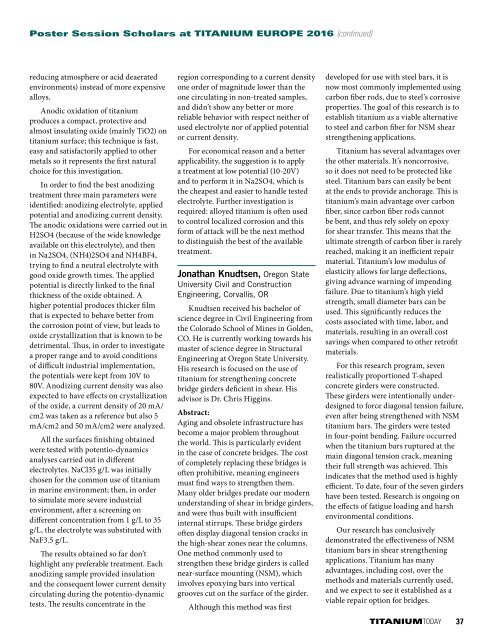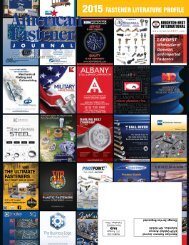100% Positive Material Identification
23mhiW2
23mhiW2
Create successful ePaper yourself
Turn your PDF publications into a flip-book with our unique Google optimized e-Paper software.
Poster Session Scholars at TITANIUM EUROPE 2016 (continued)<br />
reducing atmosphere or acid deaerated<br />
environments) instead of more expensive<br />
alloys.<br />
Anodic oxidation of titanium<br />
produces a compact, protective and<br />
almost insulating oxide (mainly TiO2) on<br />
titanium surface; this technique is fast,<br />
easy and satisfactorily applied to other<br />
metals so it represents the first natural<br />
choice for this investigation.<br />
In order to find the best anodizing<br />
treatment three main parameters were<br />
identified: anodizing electrolyte, applied<br />
potential and anodizing current density.<br />
The anodic oxidations were carried out in<br />
H2SO4 (because of the wide knowledge<br />
available on this electrolyte), and then<br />
in Na2SO4, (NH4)2SO4 and NH4BF4,<br />
trying to find a neutral electrolyte with<br />
good oxide growth times. The applied<br />
potential is directly linked to the final<br />
thickness of the oxide obtained. A<br />
higher potential produces thicker film<br />
that is expected to behave better from<br />
the corrosion point of view, but leads to<br />
oxide crystallization that is known to be<br />
detrimental. Thus, in order to investigate<br />
a proper range and to avoid conditions<br />
of difficult industrial implementation,<br />
the potentials were kept from 10V to<br />
80V. Anodizing current density was also<br />
expected to have effects on crystallization<br />
of the oxide, a current density of 20 mA/<br />
cm2 was taken as a reference but also 5<br />
mA/cm2 and 50 mA/cm2 were analyzed.<br />
All the surfaces finishing obtained<br />
were tested with potentio-dynamics<br />
analyses carried out in different<br />
electrolytes. NaCl35 g/L was initially<br />
chosen for the common use of titanium<br />
in marine environment; then, in order<br />
to simulate more severe industrial<br />
environment, after a screening on<br />
different concentration from 1 g/L to 35<br />
g/L, the electrolyte was substituted with<br />
NaF3.5 g/L.<br />
The results obtained so far don’t<br />
highlight any preferable treatment. Each<br />
anodizing sample provided insulation<br />
and the consequent lower current density<br />
circulating during the potentio-dynamic<br />
tests. The results concentrate in the<br />
region corresponding to a current density<br />
one order of magnitude lower than the<br />
one circulating in non-treated samples,<br />
and didn’t show any better or more<br />
reliable behavior with respect neither of<br />
used electrolyte nor of applied potential<br />
or current density.<br />
For economical reason and a better<br />
applicability, the suggestion is to apply<br />
a treatment at low potential (10-20V)<br />
and to perform it in Na2SO4, which is<br />
the cheapest and easier to handle tested<br />
electrolyte. Further investigation is<br />
required: alloyed titanium is often used<br />
to control localized corrosion and this<br />
form of attack will be the next method<br />
to distinguish the best of the available<br />
treatment.<br />
Jonathan Knudtsen, Oregon State<br />
University Civil and Construction<br />
Engineering, Corvallis, OR<br />
Knudtsen received his bachelor of<br />
science degree in Civil Engineering from<br />
the Colorado School of Mines in Golden,<br />
CO. He is currently working towards his<br />
master of science degree in Structural<br />
Engineering at Oregon State University.<br />
His research is focused on the use of<br />
titanium for strengthening concrete<br />
bridge girders deficient in shear. His<br />
advisor is Dr. Chris Higgins.<br />
Abstract:<br />
Aging and obsolete infrastructure has<br />
become a major problem throughout<br />
the world. This is particularly evident<br />
in the case of concrete bridges. The cost<br />
of completely replacing these bridges is<br />
often prohibitive, meaning engineers<br />
must find ways to strengthen them.<br />
Many older bridges predate our modern<br />
understanding of shear in bridge girders,<br />
and were thus built with insufficient<br />
internal stirrups. These bridge girders<br />
often display diagonal tension cracks in<br />
the high-shear zones near the columns.<br />
One method commonly used to<br />
strengthen these bridge girders is called<br />
near-surface mounting (NSM), which<br />
involves epoxying bars into vertical<br />
grooves cut on the surface of the girder.<br />
Although this method was first<br />
developed for use with steel bars, it is<br />
now most commonly implemented using<br />
carbon fiber rods, due to steel’s corrosive<br />
properties. The goal of this research is to<br />
establish titanium as a viable alternative<br />
to steel and carbon fiber for NSM shear<br />
strengthening applications.<br />
Titanium has several advantages over<br />
the other materials. It’s noncorrosive,<br />
so it does not need to be protected like<br />
steel. Titanium bars can easily be bent<br />
at the ends to provide anchorage. This is<br />
titanium’s main advantage over carbon<br />
fiber, since carbon fiber rods cannot<br />
be bent, and thus rely solely on epoxy<br />
for shear transfer. This means that the<br />
ultimate strength of carbon fiber is rarely<br />
reached, making it an inefficient repair<br />
material. Titanium’s low modulus of<br />
elasticity allows for large deflections,<br />
giving advance warning of impending<br />
failure. Due to titanium’s high yield<br />
strength, small diameter bars can be<br />
used. This significantly reduces the<br />
costs associated with time, labor, and<br />
materials, resulting in an overall cost<br />
savings when compared to other retrofit<br />
materials.<br />
For this research program, seven<br />
realistically proportioned T-shaped<br />
concrete girders were constructed.<br />
These girders were intentionally underdesigned<br />
to force diagonal tension failure,<br />
even after being strengthened with NSM<br />
titanium bars. The girders were tested<br />
in four-point bending. Failure occurred<br />
when the titanium bars ruptured at the<br />
main diagonal tension crack, meaning<br />
their full strength was achieved. This<br />
indicates that the method used is highly<br />
efficient. To date, four of the seven girders<br />
have been tested. Research is ongoing on<br />
the effects of fatigue loading and harsh<br />
environmental conditions.<br />
Our research has conclusively<br />
demonstrated the effectiveness of NSM<br />
titanium bars in shear strengthening<br />
applications. Titanium has many<br />
advantages, including cost, over the<br />
methods and materials currently used,<br />
and we expect to see it established as a<br />
viable repair option for bridges.<br />
TITANIUMTODAY 37







